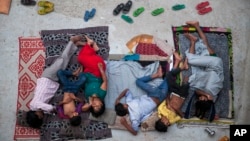Hot weather has been a serious problem across India for nearly two weeks. Rainfall brought lower temperatures and relief to a few places. But across large parts of the country, the heat wave has showed no sign of letting up.
This is the world’s fifth-deadliest heat wave. That finding comes from the Emergency Events Database, a disaster center based in Belgium.
Chandra Bhushan works for the New Delhi-based Center for Science and Environment. He says India is used to dealing with high temperatures. But he says this year, the heat turned deadly as temperatures rose very quickly. He says the temperatures rose “very, very fast,” from the first week in May, increasing by close to 15 to 20 degrees Celsius.
In Andhra Pradesh state, officials have advised people to stay in the shade, out of the sun. But many poor people cannot follow that advice. They earn their wages by working outside, with little or no protection from the hot weather.
In crowded cities, it is difficult for people to keep cool. Paved road surfaces and the lack of tree cover drive temperatures higher.
In many places, the air temperature has been around 45 degrees Celsius.
R.S. Deshpande is with the Indian Institute of Social Science Research. He says that like most disasters, poor people are hit the hardest. They do not have the right clothing to keep cool. They also do not have homes equipped to protect them from hot weather. Their earnings can drop, he says, because there are more health costs and maybe less work during the summer heat.
Experts say that while heat waves are now considered “disasters,” they do not get the same attention as cyclones and earthquakes. But as the killer heat wave continues, there are more calls for Indian officials to do more to be ready for this kind of weather crisis.
To date, only one Indian city has put in place a “Heat Action Plan” to protect its residents. That city is Ahmedabad in the western state of Gujarat. Its measures include public information campaigns and setting up “cooling spaces” in shopping malls and other public buildings. The action plan also calls for training of doctors, and helping construction supervisors protect their workers.
Dileep Mavalankar is director of Ahmedabad’s “Heat Action Plan.” He says the plan helped reduce deaths during a major heat wave last June. He says its many measures are like those used in Europe after the continent’s killer heat wave 12 years ago.
He says efforts to help other Indian cities develop their own action plan were not well received. Only two states showed interest in using a plan like the one in Ahmedabad.
Climate experts warn these large heat waves could become more common in the future. The recent heat wave could put pressure on governments to come up with plans to deal with the future extreme heat waves.
Chandra Bhushan is calling for better weather forecasting systems. He wants authorities to take measures to help people deal with the extreme temperatures. If a warning is announced, he says, the first need is to stop manual work outside during the middle of the day. That is the hottest time of the day.
“The second concern is we will have to upgrade our public infrastructure much more for heat waves, whether it is about providing water at public places, having dehydration salts at public places, much more, you know, alert health care systems.”
As experts discuss what to do in the future, most Indians are looking for a break from the heat today. For now, people are waiting for seasonal monsoon rains to begin. Usually, those rains hit India’s southern coast by this time. Weather officials say they could come any day.
I’m Anne Ball.
Anjana Pasricha reported this story for VOA. Anne Ball wrote it for Learning English. George Grow was the editor.
______________________________________________________________
Words in This Story
relief – n. a good feeling that someone has when something unpleasant stops.
pave(d) – v. covered
promote – v. to raise something (or someone) to a higher position
manual – adj. to do something by





